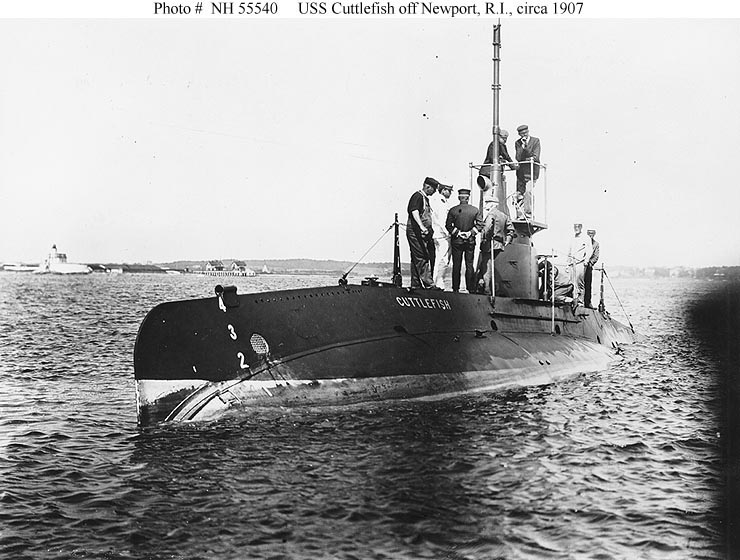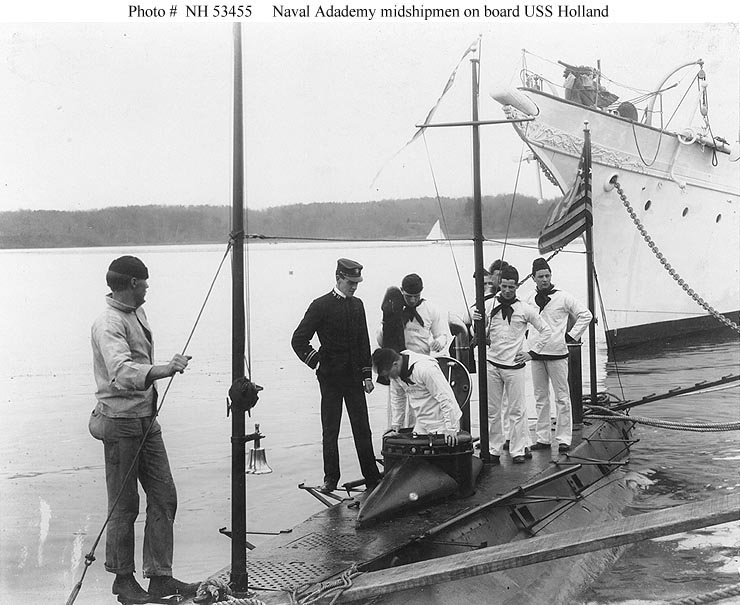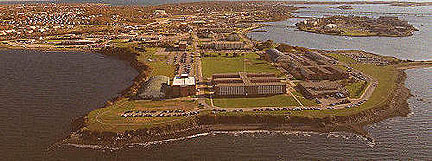Deployments - the Early Years - East Coast | ||
The story is often told that John P. Holland sold US Navy it's first submarine. However - that isn't quite the way it happend. Holland's sixth design incorporated everything he had learned so far about building practical submarines - but the US Navy still wouldn't buy it. Once the new sub had been tested - it was decided that putting the rudder behind the propeller instead of in front of it would greatly improve the sub's handling characteristics. Holland didn't have enough money to accomplish the change so they approached an investor to finance the project. The investor was so impressed - he not only funded the project - but he also bought out Holland's company - submarine and all. He named the new company the Electric Boat Company and shorty moved it to a yard at New Suffolk. After more tests - a 500 mile trip to prove it's worthiness - in the spring of 1900 the US Navy finally bought the boat - and named it the USS Holland. While Electric Boat's investment in the Holland was over $200,000 - the Navy only paid $150,000. Once in the Navy's hands - it proved itself in tests against surface vessels - so much so that the Navy Commissioned the boat USS Holland in Oct. of 1900. Electric Boat's decision to let the Navy buy the Holland so cheap proved a wise investment - as the Navy then purchased an additional six subs. Holland didn't have enough money to accomplish the change so they approached an investor to finance the project. The investor was so impressed - he not only funded the project - but he also bought out Holland's company - submarine and all. He named the new company the Electric Boat Company and shorty moved it to a yard at New Suffolk. After more tests - a 500 mile trip to prove it's worthiness - in the spring of 1900 the US Navy finally bought the boat - and named it the USS Holland. While Electric Boat's investment in the Holland was over $200,000 - the Navy only paid $150,000. Once in the Navy's hands - it proved itself in tests against surface vessels - so much so that the Navy Commissioned the boat USS Holland in Oct. of 1900. Electric Boat's decision to let the Navy buy the Holland so cheap proved a wise investment - as the Navy then purchased an additional six subs. | ||
 | ||
 | ||
| Boats in the front group are (from left to right): In the background, by the breakwater are (left-right): Photographed by Legendre & Levick, New York. | ||
The ADDER, MOCCASIN, PLUNGER, PORPOSE and SHARK formed the first submarine fleet and were operated around New Suffolk and Newport. It was at New Suffolk where the USS HIST became the first "mother" ship - the first tender - ordered to tender duty in March of 1903. HIST would tend the boats around New Suffolk and Newport RI until reassigned in 1905
| ||
 | ||
In an effort to familiarize the greatest number of officers to the new technology - the Navy decided to operate the boats in and around the Naval Academy at Annapolis. This had the desired effect that many new officers decided to give the new boats a try - ensuring a good supply of able bodied, qualified and not prejudiced officers for command.
After HIST - several tenders were deployed in the Newport / Annapolis / Norfolk operating area: the USS NINA; USS CASTINE; USS DIXIE and USS FULTON (AS 1) - with DIXIE serving the last Deployment ending in 1915. Norfolk is covered on it's own page. | ||
| Continue on to the next page: Deployments - The Early Years - The West Coast | ||
| Return to TenderTale Main Page © 2005 Common Cents Computers |

